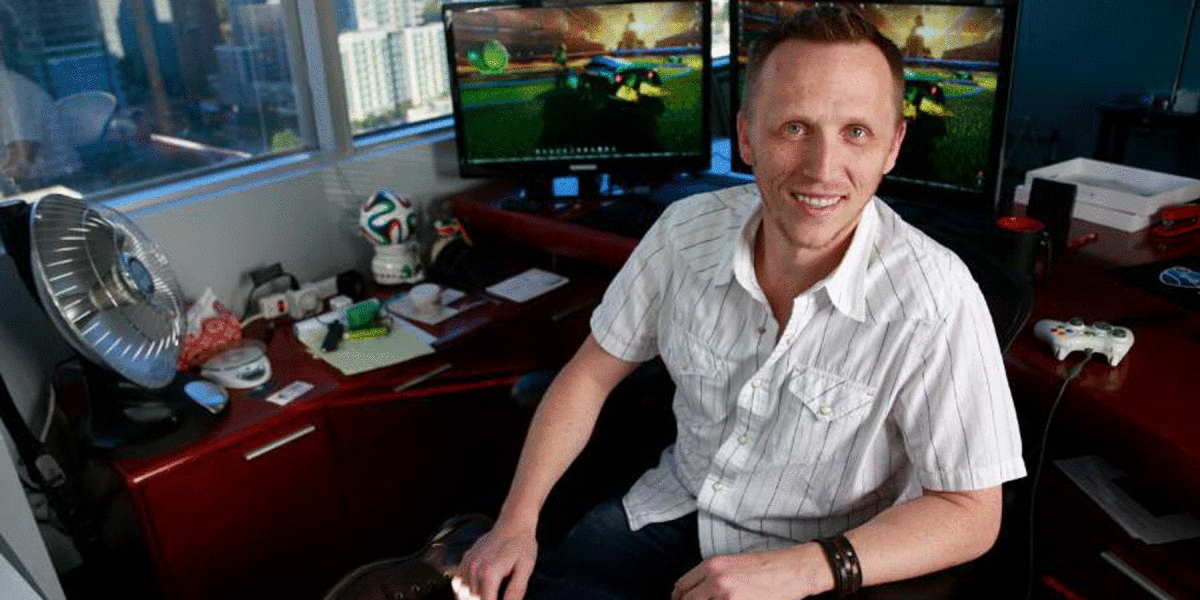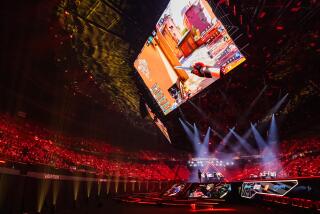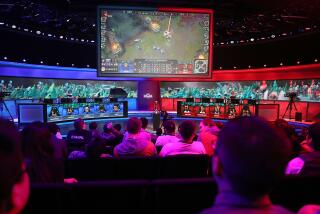The Player: How ‘Rocket League’ combined cars with soccer to create video game magic
Dave Hagewood didn’t set out to create the next big thing in electronic sports. Ten years ago he simply envisioned a game in which cars did crazy things.
Cars with rockets on them.
The result was the breakout independent game of 2015, “Rocket League.”
The key to its success was one simple addition to Hagewood’s original vision: a giant, bouncy soccer ball. Thus, a zany game in which cars crashed into one another became something else entirely, a madcap sport.
Discuss this story on our Facebook page >>
“Rocket League” has now reached more than 12 million players, with revenue topping $70 million. In late February the game — already a hit on Sony’s PlayStation 4 and computing platform Steam — arrived on Microsoft’s Xbox One, where in less than a month it attracted more than 1 million players. On a recent midweek afternoon, 120,000 people were playing the game at once.

Psyonix founder Dave Hagewood initially dreamed-up an extreme sports-like game with cars.
That’s a big deal for a midsize studio. Before “Rocket League,” Psyonix, based in downtown San Diego, was known largely for its contract work, helping bigger studios fine-tune production on “Mass Effect 3,” “Gears of War” and other titles.
“Rocket League” worked because Hagewood and the young Psyonix team were stubborn. A passion project, and one developed over a course of two years with a budget shy of $2 million, Team Psyonix for much of the past decade has wanted to play soccer with cars.
“It’s a great example of why the video game industry is so unique,” said Sundance DiGiovanni, co-founder of e-sports organizer Major League Gaming.
“Psyonix is a decent-sized studio, but it’s not a major, by any stretch. This is not a title that was pegged to be a massive seller, but they came out with a well-crafted game that was entertaining to watch, fun as hell to play and very social. They became a significant chunk of the gaming zeitgeist for months and months.”
It’s more than just a populist game. “Rocket League” won the top independent prize at last December’s media-chosen the Game Awards, and the title is nominated for game of the year alongside name brands “Fall Out 4” and “Metal Gear Solid V: The Phantom Pain” at this month’s prestigious Game Developer’s Choice Awards.
The game is a sequel to 2008’s breathlessly titled “Supersonic Acrobatic Rocket-Powered Battle-Cars.” But you’d be forgiven for never having heard of that one. It was released only on Sony’s PlayStation 3 and took two years to turn a profit.
What it succeeded in doing, however, was hook the Psyonix team on the idea that cars plus soccer equals video game magic.
At its core, the game is simple: Drive around a stadium with remote-controlled-looking cars and chase a larger-than-life, futuristically designed ball.
But spend a few minutes with it — or watch a couple of videos on YouTube or Twitch — and it’s clear that “Rocket League” can require deep mastery.
With a sports-arena-meets-rave look and tone, “Rocket League” can be crazily fast. At times it’s a match of car versus car; other moments it requires the perfect angle to slap the ball into the goal. And that’s if you can manage to properly drive around the rink and learn how to ride the walls.
“It’s unusual for a game to stick out in the way that ‘Rocket League’ did to us,” Hagewood said last month in the Psyonix headquarters on the 16th floor of a San Diego high-rise. Outside the conference room — the only one in the office — a kitchen was fully stocked with snacks and drinks. Nearby was a plush couch and a big-screen TV. Tinted windows keep the office twilight-dark, and staffers on a lunch break were enjoying a few rounds of Nintendo’s most recent take on “Super Smash Bros.”
“We felt like we were sitting on top of a hidden secret,” Hagewood said. “We’ve all worked on big games — ‘Gears of War’ and ‘Unreal Tournament’ and ‘Mass Effect.’ This is cool stuff. They’re great games, but there’s something very special about building something that’s completely off the wall.”
It hooked Blake “CloudFuel” Tull months before it was released. He caught a mention of the game on a Reddit forum and was able to play the beta version. Today, Tull, based in Houston, runs the online community Rocket League Central, which posts news on the game and its top players as well as hosts events and tournaments.
“I do think the game is very approachable,” said the 30-year-old, who works in logistics for the oil and gas industry. “It’s got a high skill ceiling, so there is the potential to be really competitive at it, but there’s also a low entry point. You can get in pretty easily. It’s not a hard concept. You hit the ball into the goal. It’s the simplest thing you can do. It’s taking it to the next level and the next level and the next level that keeps you going.
“You think it’s this goofy silly thing, but you get in and realize it’s very skill based.”
‘Impossible dream’
Hagewood, 40, wasn’t always a video game designer. He once had a whole other career, running a Web-hosting firm in Satellite Beach, Fla.
In his spare time, he tinkered with game programs and in the late ‘90s and early 2000s was part of a then-burgeoning fan-driven modding community — passionate enthusiasts who make freely available adjustments or additions to popular games. His specialty was vehicles, and he was working on a way to place cars in Epic Games’ “Unreal Tournament 2003.”
This was before major universities had game design tracks, and Hagewood’s modding was destined to be a hobby, unless he got lucky. He got lucky.
“I had written off game development as something that was an impossible dream,” he said. “Growing up, I remember reading articles in high school that were like, ‘How to be a game developer. Step One: Forget it.’”
Hagewood’s work was so polished that it caught the attention of Epic Games, and after meeting with the company at the industry trade show the Game Developers Conference, he was brought on in 2003 as a contract game developer. Hagewood moved to the Raleigh, N.C.-area to be closer to Epic. The timing worked out, as Hagewood began to realize that Web hosting was not his calling.
“When I started the Web-hosting company I was trying to be practical,” Hagewood said. “I was looking for what the next big thing was. It was definitely the Internet. You could see it. In the ‘90s it was like, ‘OK, this is going to be big.’ So I bet hard on it, but it was rough because everyone else was betting hard on it.”
Psyonix at this time was largely just Hagewood. Well, Hagewood and interns from nearby universities. He survived on picking up contracts from Epic, but he had two goals: One, move West, and two, create an original game.
Thomas Silloway, 30, Psyonix’s director of development, started with the company in North Carolina as an intern 10 years ago. He remembers Hagewood and another developer tinkering with an early version of what would become “Rocket League.”
“They were working on a car prototype that they called ‘Track Addict,’” Silloway said. “It was a rocket power car just like you’d see in ‘Rocket League.’ This was in 2006. It was a time trial platforming game. It was in space, and there were floating platforms with curved banks. You had to conserve your boosts and jump and fly from platform to platform to see how fast you could complete a course. It was really them just tinkering with vehicle physics.”
Hagewood said he was partly inspired by extreme sports games like “Tony Hawk” or snowboarding title “SSX.” He wanted cars to engage in combat but also do absurd jumps and flips.
“There were UFOs flying around you, and you could increase your size to a giant car and crush the other cars,” he said. “We even had a crazy weapon called the blowfish gun, where you would ... hit the other car and inflate the other car into a balloon. It was really wacky.”
Psyonix began pitching the game. Microsoft, Hagewood said, gave the company the green light to release it on the Xbox. And then someone added a soccer ball to the game.
“People always ask about the origin of the game,” Silloway said. “To be completely honest, we didn’t even mean to make this game. We were making a completely different game and someone threw a ball into the level. We were hitting it around, and we became addicted to it. We were playing it all the time. So we either needed to stop playing it, because we weren’t getting work done on the other thing, or we had to make it our full-time product. That’s what we ended up doing.”
Hagewood, embarrassed, went to Microsoft and said they were going to make a different game than they had pitched. They went their separate ways, and “Supersonic Acrobatic Rocket-Powered Battle-Cars” came out on the PlayStation 3 in 2008.
The following year, Psyonix moved to San Diego.
A slow build
Though the game didn’t immediately click with a large audience, it found its champions — enough of them that Hagewood decided if Psyonix would make another game it would be a sequel. While the bulk of Psyonix, which now numbers about 50 people, worked on contract projects, Hagewood kept a couple of employees tinkering on what became “Rocket League.”
That “Supersonic Acrobatic Rocket-Powered Battle-Cars” was a slow build turned out to work in Psyonix’s favor. By the time the sequel was ready, the game landscape would have changed dramatically.
Today, e-sports are big business and can sell out the Staples Center. And sites such as YouTube and Twitch have turned gaming into a spectator sport. Knowing that it “was difficult to get people to understand that it’s worth sitting down and playing a game about rocket cars,” Hagewood and Psyonix made it a priority to get alpha and beta versions of the game in the hands of well-known video-game streamers.
Also in “Rocket League’s” favor: When the $19.99 game was released on the PlayStation 4, it was free to subscribers of Sony’s $50-per year PlayStation Plus membership program.
“The game is really good for streaming,” said Patrick Walker, vice president of insights at video game industry consultancy EEDAR. “It creates a lot of really exciting moments in a match, like the demolition of cars. It really took advantage of the Twitch service in creating really cool streaming video, which is something that’s getting more and more important.”
If the original took two years to turn a profit, for the sequel it was a matter of days. Part of the hook, theorizes Hagewood, is that it’s a team sport. In most sport simulation games such as the “FIFA” or “Madden” series, the player manages a full squad. In “Rocket League,” the player controls just one car on the field, further highlighting the importance of one’s individual skill.
“It is more like a sport than other games,” Hagewood said. “It addicts you like a sport. Basketball. Football. Baseball. Those games are timeless. Video games usually aren’t like that, but this one feels more like it can be. In the future, maybe we upgrade the graphics, but do we change it? That doesn’t make sense.”
More to Read
The biggest entertainment stories
Get our big stories about Hollywood, film, television, music, arts, culture and more right in your inbox as soon as they publish.
You may occasionally receive promotional content from the Los Angeles Times.











